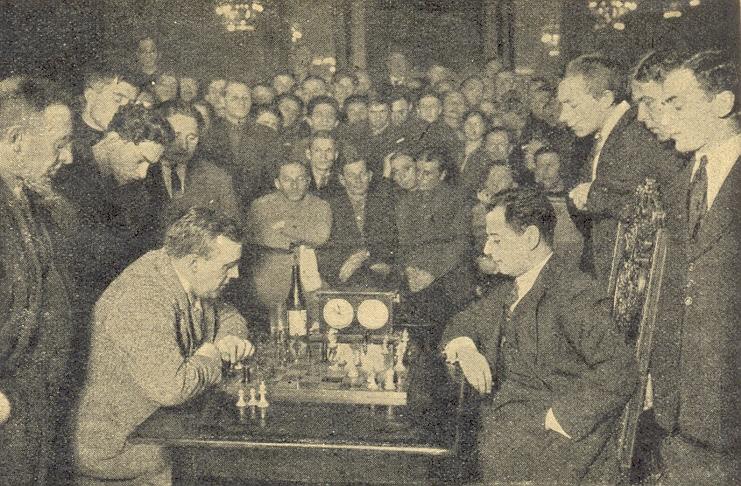
Edward Winter
One of the most complex games ever played was Capablanca v Bogoljubow, Moscow, 1925. It has been dissected not only by both players but also by such luminaries as Lasker, Alekhine, Euwe, Spielmann and Tartakower. Many of their comments reflect profound disagreement, as will be seen in the compendium presented below. It was prepared in two stages. After assembling the masters’ assessments, we submitted a draft to Richard Forster, whose detailed comments were then incorporated at numerous stages.
The occasion itself was tense. The game was played in the nineteenth of 21 rounds, at which time the leading positions were: 1. Bogoljubow, 14½ points; 2. Lasker, 12½ points; 3. Capablanca, 11½ points; 4-6. Marshall, Réti and Torre, 10½ points. Capablanca (and Réti) had the handicap of a bye in one of the last three rounds. The Cuban world champion had lost two games to lesser lights (Ilyin-Genevsky and Verlinsky).

Source: page 41 of Tartakower’s Shakhmatnaya pravda (Leningrad, 1926), as specified in C.N. 4830.
José Raúl Capablanca – Efim Dmitrievich Bogoljubow
Moscow, 5 December 1925
Queen’s Gambit Accepted
1 d4 d5 2 c4 e6 3 Nf3 dxc4
Capablanca, in his annotations on pages 34-35 of the January 1926 issue of Kagans Neueste Schachnachrichten: ‘Probably with the intention of simplifying the game, in consideration of how White handled this variation in previous games during this tournament. However, in the present case White had to play for a win in order to come third, and therefore wished to simplify the game only if compelled to.’
Alekhine annotated the game on page 12 of the January 1926 Revue suisse d’échecs. His notes were dated ‘London, 30 December 1925’, although that was the day he played Colle in the Hastings tournament. Of Black’s third move he wrote: ‘It is better to accept the gambit on the second move or the fourth (after 3...Nf6 4 Nc3, for example.; 4...dxc4 5 e4 Bb4!). Now White obtains a clear advantage by advancing his e-pawn two squares.)’
[Forster: ‘Alekhine’s opinion about the right moment to take on c4 has been considered correct up until modern times, but doubts have recently arisen. The position after 3...dxc4 has been reached in several top-class games: for example, Xu Jun v Ivanchuk, Lucerne, 1993 (0-1, 62); Yusupov v Ivanchuk, Riga, 1995 (½-½, 31); Kramnik v Ivanchuk, Dortmund, 1995 (1-0, 50); Lobron v Lautier, Dortmund, 1995 (1-0, 44); Kramnik v Ehlvest, Novgorod, 1995 (0-1, 30). But in none of them was the theoretical recommendation 4 e4 played. Instead 4 Qa4+ or 4 e3 was preferred.’]
4 e4
Bogoljubow (in the tournament book): ‘The books recommend 4 e3, but Black then has far fewer difficulties.’
4...c5
Capablanca: ‘4...Nf6 instead of the text move deserved consideration.’ Unless otherwise stated, all Capablanca quotations in the present article come from A Primer of Chess (London, 1935).
Alekhine: ‘If 4...Nf6 then 5 Bg5 h6 6 Bxf6 Qxf6 7 Bxc4 with advantage.’
[Forster: ‘The revival of the variation was based not on 4...Nf6, which was never thoroughly analysed because after the Capablanca v Bogoljubow game Black refrained from 3...dxc4, but on the crude 4...b5. An example is Khalifman v Ivanchuk, Tilburg, 1994, which Black won.’]
5 Bxc4
Tartakower (on page 85 of Kagans Neueste Schachnachrichten, 1926, Sonderheft No. 1): ‘The fact that White achieves little by the vehement thrust 5 d5 exd5 6 exd5 Nf6 7 Bxc4 Bd6 8 O-O O-O was shown by the game Capablanca v Subarev in the 17th round, even though the novelty 9 Bg5! (instead of 9 Nc3 a6 10 a4 h6!) 9...Bg4 10 Nc3 Nbd7 11 Ne4 Qc7 (11...Be5! is better) 12 Bxf6 Nxf6 13 Nxf6+ gxf6 14 h3 Bh5 15 Re1 etc. disorganized Black’s king’s side.’
5...cxd4
Lasker (whose analysis of the game in De Telegraaf of 20 December 1925 was reproduced on pages 285-286 of the December 1925 issue of Tijdschrift van den Nederlandschen Schaakbond): ‘If 5...Nc6 then 6 d5 would be to White’s advantage.’
6 Nxd4 Nf6
Tartakower: ‘If 6...e5, 7 Nb5 with advantage.’
Deutsche Schachblätter January 1926, pages 10-11: 6...e5 with the aim of an exchange of queens would be too naïve because of 7 Qb3.’ [Forster: ‘7 Qb3 Qxd4 8 Bxf7+ Kd8 9 O-O, with a large advantage.’]
In Partidas Clásicas de Capablanca (Buenos Aires, 1943) Gideon Ståhlberg and P. Alles Monasterio wrote: ‘Against Spielmann at the 1929 Carlsbad tournament Grünfeld played 6...b6, but after 7 Nc3 Bd7 8 O-O Nc6 9 Nf3 Qc7 10 Qe2 Bd6 11 Rdl Nge7 12 Be3 Ne5 13 Nxe5 White obtained much the better position.’ Grünfeld’s actual move was 6...a6.
[Forster: ‘If Black has this position nowadays he prefers 6...a6. An example is Douven v Fischer Nielsen, Groningen, 1990: 1 d4 d5 2 c4 dxc4 3 e4 c5 4 Nf3 e6 5 Bxc4 cxd4 6 Nxd4 a6 7 O-O Nf6 8 Bg5 Be7 9 e5 Nfd7 10 Bf4 b5? 11 Bxe6! (The thematic sacrifice.) 11...fxe6 12 Nxe6 Qb6 13 Nxg7+ Kf7 14 Nf5 Nf8 15 Nxe7 Kxe7 16 Nc3 Bb7 17 Nd5+ Bxd5 18 Qxd5 Qc6 19 Bg5+ Ke8 20 Qd8+ Kf7 21 Qe7+ Kg6 22 Rad1 Black resigns.’]
7 Nc3
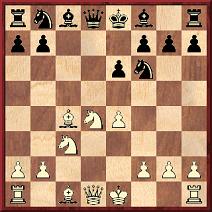
7...Bc5
Bogoljubow: ‘This move has been censured by many critics, but unfortunately Black had nothing better. For instance, after 7...Be7 there would follow 8 e5 Nd5 9 Qg4! with the better position. After 7...e5 8 Ndb5 Qxd1+ 9 Kxd1 Na6 10 Be3! Ng4 11Bxa7! Rxa7 12 Nxa7 Nxf2+ 13 Ke2 Nxh1 14 Nxc8 Bc5 15 Rxh1 O-O 16 Bxa6 bxa6 17 Na4 White is a piece ahead.’ Vassily Panov’s book on Capablanca (Moscow, 1959) repeated Bogoljubow’s analysis without giving credit.
Fred Reinfeld’s The Immortal Games of Capablanca adds to Bogoljubow’s variation: ‘Note that if 15...Kd7 16 Bxa6 bxa6 17 Na4 Rxc8 18 Rd1+ Ke6 (if the bishop interposes, 19 Nb6+ wins) 19 Rc1 Kd6 20 b4 wins.’)
Golombek, in Capablanca’s Hundred Best Games of Chess (London, 1947): ‘The text move is not altogether satisfactory ... nor can the more modest 7...Be7 be recommended, since White gets much the better game by 8 e5 Nfd7 9 Qe2 O-O 10 O-O a6 11 Rd1 Qc7 12 Bf4 b5 13 Bd3 Bb7 14 Rac1, and the violent 7...e5 8 Ndb5 Qxd1+ 9 Kxd1 Na6 10 Be3 b6 11 f3 leaves White ahead in development. Safest is therefore 7...Nbd7, preventing the disorganizing thrust, e5.’
Tartakower: ‘7...Bb4 would be bad: 8 Qa4+ Nc6 9 Nxc6 Bxc3+ 10 bxc3 bxc6 11 Qxc6+ Bd7 12 Qb7 Rb8 13 Qxa7 Nxe4 14 Ba3, etc. and White has supremacy. [Forster: ‘Tartakower’s last move is not very convincing because of 14...Ra8 15 Qd4 Rxa3 16 Qxe4 Rxc3, but 14 O-O or 14 Qe3 keeps a big advantage.’] However, 7...Nbd7 already now was to be considered.’ Annotating the game on pages 105-108 of Schachmethodik (Berlin, 1928 and 1929), the source of all future Tartakower quotes in this article, he wrote: ‘Peaceful development by 7...Be7 would also be admissible, since the combination 8 e5 Nfd7 9 Bxe6 would be incorrect because of the reply 9...Nxe5!’ [Forster: ‘Here Tartakower exaggerates. 9...Nxe5 is indeed the best move, because 9...fxe6 10 Nxe6 Qb6 11 Nd5! loses, but after 9...Nxe5 10 Bxc8 Qxc8 11 O-O White still has the advantage.’]
Euwe and Prins, in Het Schaakphenomeen José Raoul Capablanca y Graupera: ‘7...a6 was probably also good, in order to play an eventual ...b5 and to answer 8 a4 by 8...Bb4 (a move not possible immediately because of 8 Qa4+). The game might continue: 7...a6 8 e5 Nd5 9 Bxd5 exd5 10 O-O Nc6, and Black’s position is by no means hopeless, although it must for the time being be handled with great care.’
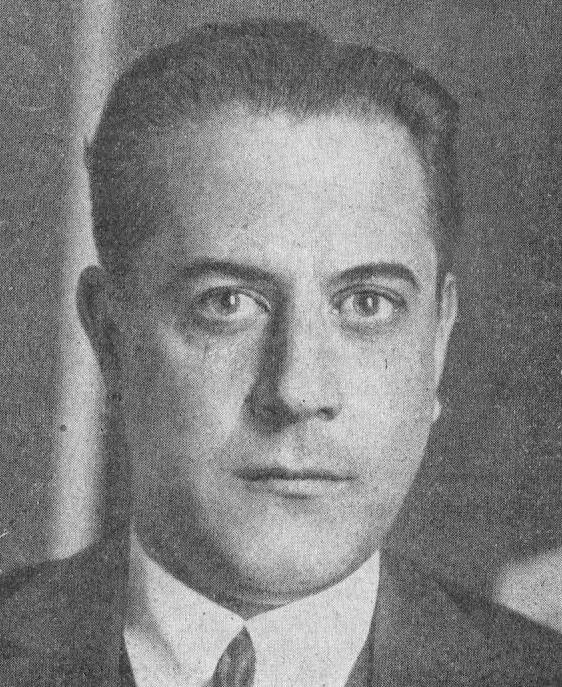
José Raúl Capablanca
8 Be3
Capablanca: ‘As a result of the system of development adopted by Black, White has gained a move. White has already developed both his knights and his bishops while Black has developed only one knight and one bishop. In a fairly open position like this, such a thing generally leads to loss of some sort. Black is already hard pressed to find a satisfactory move. If 8...O-O 9 e5 Nd5 10 Bxd5 exd5 11 O-O with a decided advantage to White.’
Bogoljubow: ‘In this position I was able to find, after very long thought, no satisfactory defence. After 8...Bxd4 9 Bxd4 O-O (or 9...Nc6) 10 Bc5 White retains the advantage. If 8...Nc6, White replies 9 Nxc6. Finally, after 8...O-O 9 O-O (not 9 Nxe6) 9...Nbd7 10 Qe2 Ne5 11 Rfd1! White has a won game.)’ [Forster: ‘8...O-O was not that bad, as Euwe/Prins demonstrate. After 8...Bxd4 9 Bxd4 the critical variation is 9...Nc6 10 Bc5 Qa5!? 11 Ba3! Nxe4 12 Rc1!, and White has very good compensation for the pawn.’]
Euwe and Prins: ‘This threatens to win a pawn by 9 Nxe6 Bxe6 10 Bb5+, followed by 11 Bxc5 or 9 Nxe6 Qxd1+ 10 Rxd1 Bxe6 11 Bb5+, etc.’
8...Nbd7
Capablanca: ‘Black wanted to prevent e5. He could not play 8...e5 because of 9 Ndb5.’ In Kagans Neueste Schachnachrichten the Cuban wrote: ‘8...O-O was to be considered. The text move gives White the possibility of a positional sacrifice which offers excellent winning chances.’
Lasker: ‘This continuation is too risky. With 8...O-O Black’s game would still be defendable.’
Alekhine: ‘A serious mistake. The only move was 8...O-O, after which Black would still have been able to put up a fight against White’s superior position, since White would have no direct threats.’
Bogoljubow (who gives 8...Nbd7 an exclamation mark): ‘Black provokes the bishop sacrifice, hoping at least to obtain good tactical chances.’
Tartakower: ‘Or 8...Bxd4 9 Bxd4 Nc6 10 Bc5 Qxd1+ 11 Rxd1, etc., with advantage to White. Perhaps relatively best is 8...Qe7.’
Euwe and Prins: ‘Correct and, in my opinion satisfactory, would be 8...O-O. Without doubt White still stands better after 9 e5 Nfd7 (if 9...Nd5 then 10 Nxe6 {Ståhlberg and Alles Monasterio, as well as Panov, give ‘10 Bxd5 exd5 11 O-O with a clear advantage’.}) [Forster: ‘Euwe and Prins erred here. Capablanca’s 10 Bxd5 exd5 11 O-O secures White an advantage, while after 10 Nxe6 Bxe6 11 Bxc5 (neither 11 Nxd5 Bxe3 12 Nxe3 Qa5+ 13 Qd2 Qxe5 nor 11 Bxd5 Bxe3 12 fxe3 Qb6 gives any advantage) 11...Nxc3 12 Qxd8 Rxd8 13 Bxe6 Na4 14 Be7 Re8 15 Bb3 Black has a pleasant choice between 15...Rxe7 with the initiative or 15...Nxb2 16 Bd6 Nd3+ 17 Nxe5 with a healthy extra pawn.’] 10 f4 Nb6 [Forster: ‘Here I prefer Golombek’s suggestion of 10...Qb6 because after 11 Qd2 Nc6!? 12 Na4 Bb4! 13 Nxb6 Bxd2+ Black has a good game through either 14 Bxd2 Nxb6 15 Nxc6 Nxc4 or 14 Kxd2 Nxb6 15 Bd3 Nb4!’] 11 Bb3 Bxd4 12 Bxd4 Nc6 13 Bc5, but Black’s position is certainly not as bad as in the game. The reason for which Bogoljubow dispensed with 8...O-O, i.e. White’s reply 9 O-O, is not valid: 8...O-O 9 O-O a6 10 a4 e5, etc., or 8...O-O 9 O-O a6 10 e5 Nfd7 11 f4 b5, and in both cases Black has a satisfactory game.’
Panov: ‘8...Nc6? was not possible owing to 9 Nxc6 Qxd1+ 10 Rxd1 and if 10...Bxe3?? then 11 Rd8 mate.’

9 Bxe6
This type of sacrifice was to occur in two other Capablanca games (v Havasi at Budapest, 1928 and v Mieses at Margate, 1935). By coincidence it had been seen earlier in 1925, at the Debrecen Hauptturnier. That game, between B. Hönlinger and M. Kolósz, began 1 d4 Nf6 2 c4 e6 3 Nf3 d5 4 Nc3 Nbd7 5 e3 Be7 6 Bd3 a6 7 O-O dxc4 8 Bxc4 b5 9 Bb3 c5 10 e4 cxd4 11 Nxd4 Bb7 12 Bxe6 and White won 15 or 16 moves later. (Source: Osterreichische Schachrundschau, 12 November 1925, pages 234-235, and page 182 of Tartakower’s Das Entfesselte Schach (Kecskemét, 1926).) The latter book contains the remark ‘such a piece sacrifice seldom occurs in the opening stage’.
Bogoljubow: ‘In this game, Capablanca felt morally obliged to play for a win and he therefore made this move immediately. Whether this sacrifice should have led to a win is extremely difficult to determine.’
Alekhine: ‘Absolutely correct, since for the piece he obtains at least two pawns, as well as a very violent attack.’
9...fxe6 10 Nxe6 Qa5
Capablanca: ‘The alternative was 10...Qb6. White might then have played 11 Nxc5 Nxc5 12 O-O and Black would have extreme difficulty to guard against White’s many threats. For instance: 12...Qc6 13 Rc1 Ncxe4 14 Nxe4 Qxe4 15 Re1 Kf7 16 Rc7+ Kg6 17 Bd4 Qf4 18 Ree7 Rd8 19 Rxg7+ Kh6 20 Rxh7+ Nxh7 21 Rxh7+ Kxh7 22 Qh5+ Kg8 23 Qg6+ Kf8 24 Bc5+ and wins.’
Regarding this line, Euwe and Prins state that Capablanca ‘prudently omits to make known’ how White would win after 18...Rg8 (instead of 18...Rd8). [Forster: ‘Indeed there seems to be no way for White to conclude his attack.’] Their book suggests that after 10...Qb6 ‘the strongest continuation for White is 11 Nxc5 Nxc5 12 Rc1 (with the threat of Bxc5) 12...O-O 13 Nd5 Nxd5 14 Qxd5+ Be6 15 Qxc5 Qxb2 16 O-O Qxa2 17 Bd4 Rf7 18 Ra1 Qc4 19 Rxa7.’ 16...Bxa2 (instead of 16...Qxa2) would lose by ‘17 Bd4 Qb3 18 Bxg7+ Kxg7 19 Qg5+ Kh8 20 Qe5+ Kg8 21 Rc3 Qe6 22 Rg3+ Kf7 23 Rg7+ Ke8 24 Qh5+ Kd8 25 Rd1+, etc.’ The book also gives analysis to show that White would win in case of moves other than 12...O-O (i.e. 12...Be6, 12...Bd7 and 12...Rb8). [Forster: ‘Euwe and Prins do not mention the active reply 12...Bg4!? 13 f3 (13 Qc2 Qa5!) 13...Rd8, after which 14 Nd5 Nxd5 15 exd5 (15 Bxc5 Qa5+) 15...Qb4+ 16 Kf1 Ne4!? 17 fxg4 O-O+ is bad for White. The right way is 14 Qc2 Be6 15 O-O! (15 Nd5 Nxd5 16 exd5 Qa5+ 17 Bd2 Qxa2 18 Qxc5 Qxd5, with an equal ending), with the serious threats 16 Na4 and 16 Nd5. Since after 15...Qa5 16 b4! Qxb4 17 Nd5! White has a clear advantage, Black still has huge problems.’] Euwe/Prins examine 16..Qxa2 and 16…Bxa2, but on page 120 of his 1996 book Twenty-five Annotated Games Robert Hübner offered an important improvement: 16…b6. He analysed five lines, in none of which White could obtain any significant advantage.
In Capablanca’s line, Golombek puts forward: ‘15 Bc5 Qd5 16 Re1+ Kf7 17 Re7+ Kg6 18 Bd4 Be6 (not 18...Re8 19 Bxf6) [Forster: ‘Here 19 Rxg7+ instead of 19 Bxf6 wins immediately.’] 19 Rlc7 Rhg8 20 Qd3+.’ His inaccurate numbering of the moves has been corrected here. [Forster: ‘After 20...Qf5 21 Qg3+ Kh5! it is not easy for White to break through, owing to his back-rank weakness and the threat of ...Nd5. But if White omits 19 Rcc7 Rhg8 and instead plays at once 19 Qd3+! Qf5 20 Qg3+ Kh5, he wins by 21 Qxg7, irresistibly threatening 22 h3 and 23 Be3. Black’s best defence therefore is 18...Rd8, hoping for 19 Qd3+ Qf5 20 Qg3+ Qg4!, but White has the nasty 20 Qe3!, threatening to launch a strong attack after 21 h3! Now Black must react very carefully to avoid succumbing immediately. His best line may be 20...Be6!, and after 21 Rxe6 Rxd4!, 21 Rcc7 Rxd4!, 21 Bc3!? Re8, or 21 h3 Rd7! he just seems to survive.’]
Lasker: ‘10...Qb6 11 Nxc5 Nxc5 12 O-O, threatening 13 Na4 and e5.’
Bogoljubow: ‘It was not easy to foresee that White’s attack on the f-file would be conclusive. Subsequently it was established that Black could have equalized with 10...Qb6! For example, 11 Nxc5 (White is obliged to exchange this troublesome knight) 11...Nxc5 12 O-O Qc6! Here White has four continuations at his disposal:
a) 13 Rc1 Ncxe4 14 Nxe4 Qxe4 15 Bc5 Qd5, and White’s attack can hardly break through.
b) 13 Nd5 Nxd5 (another line that comes into consideration is 13...Ne6 14 Rc1 Qd7, etc., recommended by Lasker) 14 exd5 Qd6 15 Bxc5 Qxc5 16 Qh5+ Kf8 (or perhaps 16...Kd8) 17 Rac1 Qd6 18 Rc3 h6, and the outcome is unclear. [Forster: ‘Line b) is not convincing at all. After Lasker’s 13...Ne6 14 Rc1 Qd7 White still obtains quite a dangerous attack with 15 Nxf6+ gxf6 16 Qh5+. There is a strong improvement over Bogoljubow’s variation with 15 Qd4!, followed by 16 Qxg7, and Black has serious problems. It is surprising that neither annotator considers the simple 13...Ncxe4!, which wins rather easily (14 Nxf6+ Nxf6 15 Rc1 Qd5!).’]
c) 13 e5? Nfd7! 14 Nd5 b6!, and Black obtains a counter-attack.
d) 13 Bxc5 Qxc5 14 e5 Ng4 15 Nd5 (not 15 Ne4 because of 15...Qxe5, threatening mate) 15...Be6 16 Nf4 Bf5 17 Qb3 Qb6, and Black can defend himself.’
[Forster: ‘To sum up, 10...Qb6 is probably better than 10...Qa5, although after 11 Nxc5 Nxc5 12 Rc1! Black remains in a difficult position. 12 O-O is also extremely dangerous, but no definite win has yet been demonstrated.’]
11 O-O
Alekhine: ‘Even better than 11 Nxg7+ Kf7 12 Nf5, to which Black would have replied 12...Ne5.’ Golombek also gives this variation, adding ‘13 O-O Be6 and Black will follow up with 14...Rd8 [sic – ‘R-Q1’] to get all his pieces in play’. [Forster (joint analysis with Werner Hug): ‘A better line than Golombek’s 13 O-O is 13 Qb3+! Be6 14 Nh6+ Ke7 15 Qxb7+ Bd7 (forced, as 15...Nfd7 16 Bg5+ and 15...Ned7 16 e5 lose immediately) 16 Bxc5+ Qxc5 17 O-O Rab8 18 Qa6 Rxb2 19 Rac1, and White has three pawns and a lasting initiative for the piece. Still, Alekhine’s assessment is correct, as in the game the Cuban should win almost by force.’]
Euwe and Prins: ‘Naturally 11 Nxg7+ Kf7 12 Nf5 was also an excellent option. It may be noted that 11 e5 would be refuted by 11...Bxe3 12 exf6 Nxf6. Now, however, this move comes into account: 12 e5 Bxe3 13 exf6 Nxf6 14 Nxg7+ Kf7 15 fxe3 Kxg7 16 Rxf6 Kxf6 17 Ne4+ etc. There is also a much more serious threat: 12 Bxc5 Nxc5 13 b4 Qxb4 14 Nc7+.’
11...Bxe3
Capablanca in Kagans Neueste Schachnachrichten: ‘Evidently forced. Black finds himself in a quandary.’
Deutsche Schachblätter: ‘There is clearly nothing better. If 11...Kf7 there follows 12 Nxc5 and 13 e5.’
Golombek: ‘If 11...Kf7 12 Qb3 and wins still more speedily than in the text.’
Das Schachgenie Capablanca by Isaak and Wladimir Linder (East Berlin, 1988): ‘If 11...Kf7 then 12 Nxc5 Nxc5 13 e5, followed by 14 Qd5+.’ [Forster: ‘The variations are: 13...Rd8 14 Qf3, 13...Bg4 14 Qb1! Nfd7 15 b4 Qa3 16 Nb5!, and 13...Nfd7 14 Qd5+, followed by either 15 e6 or 15 Ne4, winning. On the other hand, Golombek’s 12 Qb3 leaves some questions open after 12...Kg6! 13 Nf4+ Kh6.’]
Euwe and Prins: ‘11...Ke7 is refuted by 12 Nxc5 Nxc5 13 Nd5+.’
Tartakower: ‘11...Bf8 would be impossible, on account of 12 Nb5!’
12 fxe3
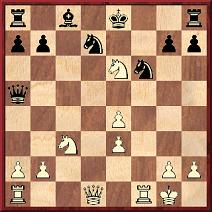
12...Kf7
Alekhine: ‘If 12...Rg8 then 13 Qd6, etc.’ Golombek adds ‘13...Kf7 14 Nd5 and Black has no adequate defence’.
Bogoljubow: ‘In view of the threats 13 Nxg7+ and 13 Nd5 Black has nothing better.’
Wiener Schachzeitung, December 1925, pages 354-355, which stated that its notes were based on those of Capablanca and Réti: ‘The threat was not only 13 Nxg7+ but also 13 Qd6.’
Euwe and Prins: ‘12...Qb6 13 Nxg7+ Kf7 14 Nd5 and wins; or 12...Qe5 13 Nxg7+ Kf7 14 Rf5 Qe7 15 Nd5 Qxe4 16 Rf4 and 17 Nh5. Against 12...g6, 13 Nd5 Nxd5 14 exd5, with the threat of 15 Qf3, is decisive. [Forster: ‘For example, 14...Qb6 15 Qf3 Ke7 16 d6+!!, with a decisive attack.’] The clearest demonstration of the hopeless situation of the Black forces is the variation 12...Rg8 13 Nd5 Rb8 (or 13...Kf7 14 Nec7 and 15 Qh5+) 14 b4 Qa3 15 Nec7+ Kd8 (if 15...Kf8, 16 e5 is decisive, and if 15...Kf7, 16 Qh5+ is decisive) 16 e5 Nxd5 17 Qxd5 Qxe3+ 18 Kh1 and Black can resign (18...Rh8 19 e6).’ [Forster: ‘After 13...Rb8 White has many ways to win, one of them being demonstrated by Euwe and Prins. In fact, after both 13...Kf7 and 15...Kf8 White could win at once with Qh5(+)! Unfortunately, Euwe and Prins do not mention Black’s best defence, i.e. 13...Nxd5! After 14 exd5 Nf6 15 Rxf6!? gxf6 16 Qh5+ Rg6 17 Nf4! (17 Qxh7 Rxg2+!) White secures a strong attack for his piece, but the outcome is far from clear. Alekhine’s (12...Rg8) 13 Qd6! is therefore definitely stronger.’]
From the monograph on Capablanca by Bengt Horberg and Jostein Westberg: ‘If 12...Qe5 then 13 Nxg7+ Kf7 14 Rf5 Qe7 15 Nd5 Qxe4 16 Rf4 Qe5 17 Nh5 with a quick finish.’
13 Qb3
Annotating the game on pages 181-182 of Časopis Československých Šachistů, December 1925, Amos Pokorný stated that 13 Qg4 would also be good, with the threat of 14 Qxg7+, with Nd5 to follow. [Forster: ‘A very surprising remark at first sight, but it is also very hard to find a satisfactory defence for Black after 13 Qg4. For example, 13...Re8 14 Qxg7+ Kxe6 15 Nd5! Nxd5 16 exd5+ Kd6 17 Qh6+ Kc7 18 Rc1+ Nc5 19 Rf7+ Bd7 20 Qf4+ Kd8 21 b4! and White wins.’] The 1997 ‘Chess Stars’ book on Capablanca (volume 1, page 275) mentions 13 Rf5 Qb6 as unclear.
13...Kg6
Tartakower: ‘13...Qb6 14 Ng5+ Kg6 15 Qf7+ Kxg5 [Forster: ‘15...Kh6 is more stubborn, but with 16 Ne6, followed by Rf3, White still wins.’] 16 Qxg7+ would lead to a quick mate.’
Pokorný gave the line 13...Nf8 14 Ng5+ Kg6 15 Qf7+ Kh6 16 Rxf6+. [Forster: ‘This is not very clear if Black simply replies 16...Ng6. Perhaps the greedy 14 Nc7+ Be6 15 Qxb7 Rd8 16 Nxe6+ Kxe6 17 Qxg7, with a quick win, is better.’]
14 Rf5
Capablanca: ‘14 Rf3 would probably win also, but the text move is better and should have brought about a quick ending.’
Lasker: ‘This is stronger than 14 Rf3, which would be answered by 14...Ne5, a move that would now be refuted by 15 Nd5, and Black is still in the game.’
Bogoljubow: ‘This is stronger than 14 Rf3, which would have been answered by 14...Ne5, a move that does not work now because of 15 Nd5!’
BCM, March 1926, pages 144-145: ‘The Viennese player Kmoch (winner of the Debrecen Tournament) puts forward here 14 Rf3 as better, with the continuation 14...Ne5 15 Rg3+ Kh6 16 Rf1 Bxe6 17 Qxe6 with a winning game. At 15 Black could have interposed at g4 either the king’s knight, when the reply would be 16 Rf1, or the queen’s knight, when the reply would be 16 Nd5.’ [Forster: ‘The critical line here is 14 Rf3 Ne5 15 Rg3+ Kh6 16 Rf1 and now, as in the game, 16...Qb6! There is no clear route for White: 17 Nxg7 Qxb3 18 Rxf6+ Ng6!, or 18 axb3 Nh5! Nor would 17 Rh3+ Kg6 18 Nf4+ Kg5 19 Qd5!? Re8! be sufficient. It is all very messy. There may be a hidden win for White, but it is certainly not easier to find than the one in the game.’]
In his booklet A Támadó Játék (Kecskemét, 1928), an item reproduced from pages 295-297 of the April-June 1927 issue of Kagans Neueste Schachnachrichten, Spielmann appended a question mark to 14 Rf5 and suggested the following: 14 Rf3 Ne5 15 Rg3+ Kh6 16 Nxg7 Qb6 17 Qa3 Qc6 18 Nb5 and 19 Nd6. Or 16...Rg8 17 Rf1 Rxg7 18 Rxf6+ Ng6 (if 18...Rg6 then 19 Qg8) 19 Qd1 (threatening 20 Qd6 and 21 Qf4+) 19...Qe5 20 Qf3 Bd7 21 Qf4+. The monograph on Capablanca by Chalupetzky and Tóth (published by Magyar Sakkvilág in 1943) reproduced Spielmann’s annotations, but gave 16 Nxg7 instead of 16 Rxg7, and 17...Qc7 rather than 17...Qc6, presumably a mere correction of typographical errors. [Forster: ‘Spielmann’s proposal 16 Nxg7 seems stronger to me than Kmoch’s 16 Rf1. Still, Spielmann’s variations are only some sample lines, and there are many other sharp variations which have yet to be examined to reach a final verdict. So far, I think that White always has very good chances, although the game continuation is even more convincing. Spielmann’s question mark for 14 Rf5 is certainly not justified.’]
14...Qb6
Euwe and Prins: ‘If 14...Ne5 15 Nd5 (given by Bogoljubow) and the knight is lost, for if 15...Nfd7 there follows mate in two moves, and if 15...Bxe6, 16 Nf4+ Kh6 17 Qxe6, with the threat of mate at h5, is decisive.’
Horberg and Westberg: ‘The best defence. After 14...Ne5 15 Nd5! Bxe6 16 Nf4+ Kh6 17 Qxe6 White wins easily.’
15 Nf4+ Kh6

16 g4
Capablanca: ‘White had practically a forced mate thus: 16 Qf7 g6 17 g4 Qxe3+ 18 Kg2 gxf5 19 g5+ Kxg5 20 Qg7+ Kxf4 21 Rf1+ Ke5 22 Qe7+ Kd4 23 Rd1+ Kc4 24 Qe6+ Kc5 25 b4+ Kxb4 26 Qb3+ and 27 Qb5 mate. Again: 16 Qf7 g6 17 g4 Qxe3+ 18 Kg2 Nxg4 19 Rh5+ gxh5 20 Qxh5+ Kg7 21 Qxg4+ Kf8 22 Ne6+ Ke8 23 Qh5+ Ke7 24 Nd5+ winning the queen. In the game itself White played differently. He thought that he could force the game, without having to go into all these complications, by playing 16 g4, which proved to be a serious mistake.’ [Forster: ‘Everybody seems to quote this Capablanca variation without checking it. 21 Ne6+! instead of 21 Qxg4+ wins instantly: 21 Ne6+ Kf6 22 Nd5+ Kxe6 23 Qxg4+, followed by 24 Nxe3, winning Black’s queen. After Capablanca’s 21 Qxg4+ Black has a more stubborn defence, i.e. 21...Kf7!, and White still has to find some accurate moves to win the game (22 Qe6+ Kf8 23 Rf1! etc.).’]
Lasker: ‘The winning move was 16 Qf7. However, the win was not very easy to find: 16...g6 17 g4 Qxe3+ 18 Kg2 gxf5 19 g5+ Kxg5 20 Qg7+ Kxf4 21 Rf1+ Ke5 22 Qe7+ Kd4 23 Rd1+ Kc4 24 Qe6+ Kc5 25 Rd5+ Nxd5 26 Qxd5+ Kb6 27 Qd6+ Ka5 28 b4 mate.’ Lasker gave a mate that was one move longer than necessary.
Alekhine: ‘With this ill-considered move White lets slip a win which could easily have been forced by 16 Qf7. If then 16...g6, White would have had a choice between two winning variations:
I. 17 g4 Qxe3+ 18 Kg2 gxf5 19 g5+ Kxg5 20 Qg7 Kxf4 21 Rf1+ Ke5 22 Qe7+ Kd4 23 Rd1+ Kc4 24 Qe6+ Kc5 25 b4+ and mate in two.
II. 17 Ne6 Rg8 (or A, B, C) 18 Rf3 Ne5 19 Rh3+ Nh5 20 Qf4+ and mate in three.
A. 17...Ne8 (or 17...Nh5) 18 Rh5+ and mate in three.
B. 17...Qxe6 18 Qxe6 gxf5 19 Nd5 Rf8 20 e5 and wins.
C. 17...Qxe3+ 18 Kh1 gxf5 19 Qg7+ Kh5 20 Rf1 Rg8 21 Rxf5+ Kh4 22 g3+ Kh3 23 Nf4+ Qxf4 24 Rxf4 Rxg7 25 Rh4 mate.’
In L’Echiquier, February 1926, page 33 Edmond Lancel noted that in this final variation there was (as Lancel pointed out in La Nation Belge of 8 January 1926) a mate in three moves by 20 Ne2, instead of 20 Rf1.) [Forster: ‘The forced mate is in four if Black begins with moves like 20...Nd5 or 20...Qc1+.’]
Bogoljubow: ‘This should have lost. The winning continuation was 16 Qf7! g6 (or a, b) 17 g4 (or c) 17...Qxe3+ 18 Kg2! gxf5 (or 18...Nxg4 19 Rh5+ gxh5 20 Qxh5+ Kg7 21 Qxg4+ and White wins easily) 19 g5+ Kxg5 20 Qg7+ Kxf4 21 Rf1+ Ke5 22 Qe7+ Kd4 23 Rd1+ Kc4 24 Qe6+ Kc5 25 b4+ Kxb4 26 Qb3+ and 27 Qb5 mate. This variation was given by Capablanca.
a) 16...g5 17 Rxg5 Qxe3+ 18 Kh1 Rg8! 19 Rxg8 and White wins.
b) 16...Qxe3+ 17 Kh1 g6 18 Rxf6 (18 Ne6 is also strong, leading to variation c) 18...Nxf6 19 Qxf6 Re8 (not 19...Bg4 because of 20 Qh4+ Bh5 21 Nxh5!) 20 Ncd5! Qf2 (not 20...Qxe4 because of 21 Qh4+ and 22 Nf6) 21 h4! and White wins easily. {Reinfeld was apparently in error when he also attributed variations a) and b) to Capablanca. Panov reproduced the present note b), as well as Capablanca’s analysis of 16 Qf7, without any acknowledgement to either master.}
c) 17 Ne6 Qxe3+ 18 Kh1 gxf5 (if 18...Rg8 then 19 Rf4) 19 Qg7+ Kh5 20 Rf1 Rg8 21 Rxf5+ Kh4 22 g3+ Kxh3 23 Nf4+!’
In variation a), Euwe and Prins added 18...Kxg5 19 Qg7+ Kxf4 20 Rf1+ Ke5 21 Qe7+ Kd4 22 Rd1+ Kc4 23 Qe6+ Kc5 24 b4+ Kxb4 25 Qb3+ and mates. In variation c), Euwe and Prins add the lines 18...Nh5 19 g4 and 18...Ne8 19 Rf3 Ne5 20 Rxe3 Nxf7 21 Rh3 mate, and give 20 Ne2! instead of Bogoljubow’s 20 Rf1.
[Forster: ‘The position after 15...Kh6 has been analysed not only very widely but also very precisely. Apart from the above-mentioned inaccuracy by Capablanca which has been reproduced nearly everywhere, and Bogoljubow/Alekhine’s 20 Rf1 instead of 20 Ne2!, there seem to be neither mistakes nor important gaps.’]
16...g5
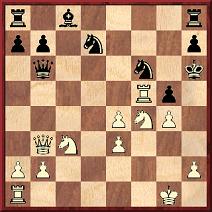
Capablanca: ‘This simple move upsets the cart.’
Bogoljubow: ‘Now 17 Qf7 is impossible owing to 17...Rf8. Black threatens to exchange queens and then play ...gxf4.’
Wiener Schachzeitung: ‘This is better than 16...Qxe3+ 17 Kg2, after which Black could not play 17...g5 on account of 18 Qf7 Rf8 19 Rxf6+, etc.’
I. and W. Linder: ‘If 16...Qxe3+ there follows 17 Kg2 g5 18 Qf7 Qd2+ 19 Kh1 Qd4 20 Ne6. If 18...Rf8 then 19 Rxf6+ Nxf6 20 Qxf8 mate. Also, 16...Qxb37 is ruled out because of 17 g5 mate!’
17 Qxb6
Alekhine: ‘This should give Black the better ending. 17 h4 was to be considered, with great complications rather in White’s favour.’ [Forster: ‘“Great complications” is true, but “rather in White’s favour” is hardly the correct assessment. See below.’]
Tartakower: ‘17 h4 offered greater chances than the text move.’
Golombek: ‘White would lose after 17 h4 Qxe3+ 18 Kf1 gxf4 19 g5+ Kh5 20 gxf6+ Kg4 21 Qe6 Kf3.’ [Forster: ‘After White missed a forced win, the annotators’ interest declines heavily, and no one tries to find the truth in the position after 17 h4. Only Golombek gives a variation, but it is an irrelevant one (for example, 21 Nd5 instead of 21 Qe6??). After 17 h4 Qxe3+ White has three sensible king moves, which are all answered similarly. For instance, 18 Kg2 gxf4 19 g5+ Kg6! 20 h5+ (20 gxf6 Qg3+ 21 Kf1 Nc5!) 20...Kg7! 21 gxf6+ Kh6. White still has many tempting continuations, but Black’s king has found relative security, and it is White’s king that is dangerously exposed. 18 Kh1 and 18 Kf1 lead to roughly the same result if Black’s king heads for the safe square h6. If there is no substantial improvement for White in these variations, 17 h4 can be dismissed as insufficient. So Golombek’s assessment was probably right, although his variation proves nothing at all.’]
Bogoljubow (who gives 17 Qxb6 two exclamation marks): ‘Capablanca finds the only possibility of retaining something of an attack.’
Euwe and Prins: ‘If White avoids the exchange of queens, his fate would be sealed. For example, 17 Nb5 Nc5, or 17 Qc2 gxf4 18 g5+ Kg6 (19 e5 Qxe3+) or 17 Qc4 Nxg4 18 Nd5 Qxb2 or, finally, 17 Qd1 Qxe3+ 18 Kf1 (otherwise 18...Nxe4) 18...b6, etc.’
17...axb6 18 Rd1
Euwe and Prins: ‘18 Nfd5 Nxg4 19 h3 Nge5 20 Rd1 Ng6, and Black’s material advantage irresistibly makes itself felt.’

Efim Dmitrievich Bogoljubow
18...Rg8
Capablanca: ‘Although Black is a piece ahead he still has trouble to get out of this position without serious loss. He should have simplified the game now by 18...gxf4 19 g5+ Kg7 (best) 20 gxf6+ Nxf6 21 Rg5+ Kf7 22 exf4 and White should have to fight hard to obtain a draw. Black failed to take advantage of the one chance he had in the whole game.’
Lasker: ‘The logical move was 18...Ra5, whereby Black would control e5. [Forster: ‘After 18...Ra5! Black should win quite easily (19 Nfd5 Nxg4).’] {The above-mentioned ‘Chess Stars’ book adds 19...Ng4 20 Rdf1 Re8 21 b4 Ra3 to the Lasker line.}18...gxf4 19 g5+ Kg6 20 Rd6! Rf8 21 exf4 would be less good.’ {Euwe and Prins give 21 Nd5 instead of 21 exf4.} [Forster: ‘In my opinion 19...Kg6 is not as bad as the annotators would have us believe. If after 20 Rd6 Black plays 20...fxe3, he obtains a passed pawn and with careful defence should win. Nonetheless, 19...Kg7! is the safer choice, and is therefore preferable.’]
Alekhine: ‘Incomprehensible! By simply taking the knight Black would have obtained at least a draw. For example: 18...gxf4 19 g5+ Kg7 20 gxf6+ Nxf6 21 Rg5+ Kf7 22 exf4 h6 23 Rg3 Nh5.’ [Forster: ‘Here too 22…Ra5 is a sensible alternative. After 23 e5 h6! 24 Rg2 Nh5! Black has excellent winning chances.’] The identical line to Alekhine’s is given by Tartakower and by Golombek, without any mention of Alekhine. Euwe and Prins write that after 23 Rb5 (e.g. 23...Rg8+ 24 Kf1, followed if possible by Rd6), it would seem that White should not lose. [Forster: ‘23 Rb5 is no improvement since 23...Rg8+ 24 Kf1 Rg4! loses a vital pawn. Even 24 Kf2 Bd7 25 Rxb6 Bc6 would fail to save the game for White.’]
Bogoljubow: ‘At best this suffices for a draw, if Black subsequently finds the best moves. In contrast, Black would have had winning chances after 18...gxf4 (18...Ra5 is also good) 19 g5+ Kg7 20 gxf6+ Nxf6 21 Rxf4 (or 21 Rg5+ Kf7 22 exf4 h6!, with a counter-attack.) 21...Ra5!’
19 Nfd5 Nxg4
Bogoljubow: ‘If 19...Rg6, there follows 20 Ne7 Nc5 21 Rd8!’ Instead Golombek has (after 19...Rg6) ‘20 Ne7 Rg7 (20...Nc5 21 Rd8!) 21 Ncd5 Nxd5 22 Nxd5 Rxa2 23 Rc1 Ra8 24 Rc7 and Black has no good continuation.’
Euwe and Prins give 19...Nxg4 a question mark and analyse 19...Nxd5 with four variations:
‘A. 20 Nxd5 Nc5 (if 20...Rxa2 then 21 Ne7, etc.; if 20...Rg7 then 21 e5, etc. Or 20...Nf8 21 Rf6+ Ng6 22 Ne7 and 23 Nf5+) 21 Rf6+ Kg7 22 Rdf1 Bxg4 23 Rf7+ Kh6 24 Nf6 Be6 25 Nxg8+ Rxg8 and there is no winning line to be found.
B. 20 exd5 Rf8 21 Rdfl Rxf5 22 Rxf5 Kg6, etc.
C. 20 Rdxd5 Nf8 21 Rf6+ Ng6 22 h3 Ra6, etc.
D. 20 Rfxd5 Nf6 21 Rd6 Rg6 22 h3 b5 23 Rb6 Nxg4 24 Rxg6+ hxg6 25 hxg4 b4 26 Nd5 Rxa2 27 Nf6 [‘Chess Stars’ offers 27 Nxb4!?] 27...Kg7 28 e5 Rxb2 and it is clearly not Black who is in danger.’
[Forster: ‘Black is better in every variation. He just escaped defeat after 16 g4 and in return commits two serious mistakes himself (18...Rg8? and 19...Nxg4?).’]
20 Ne7 Rg7
Wiener Schachzeitung: ‘The threat was 21 Nxc8, followed by 22 Rxd7.’
21 Rd6+ Kh5 22 Rf3
Alekhine: ‘Thanks to his opponent’s 18th move, White again has a won game since Black cannot play 22...Nge5 because of 23 Rh6+ and mate next move.’
Bogoljubow: ‘A very strong move which assures White of at least a draw.’
22...Ngf6
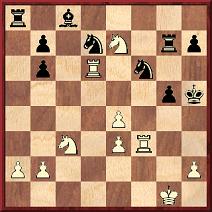
23 Rh3+
Alekhine: ‘But this check is redundant. A much simpler line was 23 Ncd5 Rf7 (if 23...Nxd5 or 23...Nxe4 then 24 Rh6+, etc.) 24 e5, etc.’
Tartakower: ‘Even more precise, as Alekhine pointed out, would be 23 Ncd5. For example, 23...Nxe4 24 Rh6+! Kg4 25 Kg2! and mate next move, or 23...Rf7 24 e5, or again, 23...Rxe7 24 Nxe7 Nxe4 25 Rd4, etc.’ [Forster: ‘What if Black simply plays 25...Ndf6 now? After 26 Rd8 he can choose between 26...Bg4 and 26...Rxa2!? 27 Rxc8 Kg4!, in both cases with the issue unresolved. Nor should Black worry too much about 25 Rh3+ Kg4 because after 26 Rdh6 he has 26...Rxa2!, while after 26 Rhh6 his king escapes by 26...Kf3! (not 26...Rxa2 27 Rd2!! – see below).’] {‘Chess Stars’ gives the line 23 Nf5 (‘?’) Kg6 24 Nxg7 Kxg7 25 e5 Ng4 26 e6 Nde5 27 Rf5 h6 28 Rxb6 Nc4 29 Rf7+ Kg6.}
23... Kg4 24 Rg3+
Bogoljubow: ‘The attempt by 24 Kg2 to mate Black would fail because of 24...Rxe7.’
24...Kh5 25 Nf5
Alekhine: ‘It is truly surprising how Capablanca complicates matters for himself in this game. Here too he could play 25 Ncd5. For instance: 25...Rxe7 26 Nxe7 Nxe4 27 Rh3+ Kg4 28 Kg2! Rxa2 29 Rd2!! Nxd2 30 Rxh7, followed by 31 h3 mate.’
Bogoljubow: ‘An interesting line would be 25 Ncd5 Rxe7! (if 25...Nxd5 there follows the problem-like finish 26 Rh6+ and 27 Rh3 mate) 26 Nxe7 Rxa2!! (not 26...Nxe4 because of 27 Rh3+ Kg4 28 Kg2! Rxa2! 29 Rd2! Ndf6! – Black must not take the rook in view of 30 Rxh7 and 31 h3 mate – 30 Rh6 Nh5 31 Rc2 Bd7 32 Rxh7, and Black is compelled to play 32...Nf4+) 27 Nxc8 Nxe4 28 Rxd7 Nxg3 29 hxg3 Kg4! and Black just manages to draw.’ [Forster: ‘A very bold statement by Bogoljubow. It is not clear how Black draws after 30 Rxh7! Kxg3 (30...Rxb2 31 Rf7!) 31 Kf1! Rxb2 32 Rf7! or 31...Kf3 32 Rh3+! Kg4 33 Rh6! Kf3 34 Rf6+! Kxe3 35 Rxb6. Even the cunning 30...Kf3 fails after 31 Rf7+! Kxe3 32 Kg2!, intending Kh3 and Kg4. The Swiss national team, including Viktor Korchnoi, contributed to this analysis. Another attempt after 25 Ncd5 is 25...Rf7 (26 e5 Ne4!, or 26 Rh3+ Kg4 27 Kg2? Nxe4!), but here White has a hidden win: 26 Nf5! Rxa2 (Black’s only chance is active play. For example, 26...Ra4 27 Rh3+ Kg4 28 Kg2 Ng8 29 Rg3+ Kh5 30 Rh6+!! Nxh6 31 Rh3+ and White mates next move by capturing at h6 with either rook or knight.) 27 h4! h6 28 hxg5 hxg5 29 Nf4+! exf4 30 exf4, and Black cannot escape mate. 25 Ncd5 should also ultimately win but there is no reason to criticize Capablanca for 25 Nf5.’] {Tartakower attributed Bogoljubow’s variation (‘a more or less forced winning line’) to Prokeš in the Czech publication 28 Rijen, but giving, in the absence of 32...Nf4+, 32...Be8 33 h3+ Kh4 34 Nf5 mate.}
25...Rg6
Euwe and Prins: ‘If the black rook had fled to, for instance, g8 it would be possible after 26 Rh3+ for the black king to step aside to g6, but this would offer no salvation: 27 Rh6+ Kf7 28 e5 Ng4 29 e6+ Ke8 30 Nd5 Nxh6 31 Nc7+ Kf8 32 Nxh6, and Black can resign.’ [Forster: ‘Euwe and Prins commit a grave error. If Black plays 31...Kd8 instead of 31...Kf87 it is White who can resign. The right move therefore is 30 Rxh7!, and Black’s position remains hopeless.’]
Pokorný: Not 25...Rg8 because of 26 e5, or 26 Rh3+! Kg6 (if 26...Kg4 then 27 Kg2) 27 Rh6+ Kf7 28 e5!
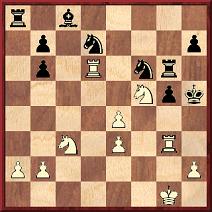
26 Ne7
Capablanca: ‘The position is most interesting. Black is in a mating net, but to finish the work is most difficult. Incidentally, all the commentators have gone wrong in their analysis of this position. They have suggested several ways of playing to force a win, but against their suggestions there are ways of getting out. There is in fact only one way to win by force and that is to play now 26 Rh3+. White actually played 26 Ne7 in order to gain time; figuring that Black could not do any better than to come back to this position. Black, however, considering this position as lost, tried to get out by giving up the exchange, and lost. [Forster: ‘This makes the reader believe that Black is lost anyway. As we shall see, he misses two very good chances in the further course of the game, and therefore 26 Ne7 was quite a serious mistake by Capablanca.’]
Let us see the variations arising from 26 Rh3+. We have then: 26...Kg4 27 Kg2 Nxe4 28 Rd5 Nxc3 29 Rh4+ gxh4 30 Nh6+ Rxh6 31 h3 mate. Again: 26 Rh3+ Kg4 27 Kg2 Nc5 28 Nh6+ Rxh6 29 Rxh6 Ncxe4 [Forster: ‘29...Nh5 is a better try. Even so, after 30 e5 Kh4!? 31 Rd4+ g4 32 Rd8!, followed by Rh8 and R8xh7 White should win.’] 30 Nxe4 Nxe4 31 Rd5 and Black cannot prevent h3 mate. A most remarkable position.’ [Forster: ‘31 h3+ Kf5 32 Rd5 mate is even more exact.’] {Panov repeated Capablanca’s analysis without any attribution.}
Tartakower mentions that if 27 Rd2 (instead of 27 Kg2) then ‘not 27...Kxh3? 28 Rg2 Nh5 29 Nd1, followed by a quick mate, but 27...Nxe4!, with salvation’. Instead of Capablanca’s 28 Rd5, he proposes: ‘28 Ne7!! Rg7 (if 28...Rxd6 then 29 Nxe4, and if 28...Nxd6 then mate is administered by 29 Rxh7 and 30 h3 mate. As can be seen, this edge-pawn mate occurs in many variations). 29 Nxe4 Rxe7 30 Ng3! Nf6 31 Rd4+ Re4 (or 31...Ne4 32 Rxh7) 32 Rxh7 Nh5 33 Rxe4+ [Forster: ‘Here either 33 Rxh5 or 33 h3+ mates next move.’] 33...Nf4+ 34 h3 mate.’ {Tartakower overlooked that 34 h3 is illegal.} [Forster: ‘Instead White plays 34 Kf2, followed by 35 h3 mate. Nonetheless, the move 28 Ne7 (originating from Alekhine?) is much worse than Capablanca’s brilliant 28 Rd5!!, because after 28...Rg7 29 Nxe4 Rxe7 30 Ng3 Black can defend by 30...Ra4! 31 Rhh6 Rxe3! with a draw at least.’]
Euwe and Prins give the variation 26 Rh3+ Kg4 27 Kg2 Ra5 28 Nh6+ Rxh6 29 Rxh6 Nxe4 30 Nxe4 (threatening Ng3 and mate) 30...Rxa2 31 Rd5 Rxb2+ 32 Nf2+ Rxf2+ 33 Kxf2 and mate follows. [Forster: ‘28 Ne7 is also strong. 29...Nh5 would be more tenacious, but 30 Rxh7! followed by 31 Rdh6! still wins. Also, Euwe and Prins missed a forced mate by, instead of 31 Rd5, 31 h3+ Kf5 32 Ng3+ Ke5 33 Rhe6 mate.’]
Alekhine: ‘The penultimate error, which generally wins the game! Instead of this repetition of moves, White could force mate as follows: 26 Rh3+ Kg4 27 Kg2 (threatening 27 Rxh7 Nxh7 28 Rxg6, etc.) 27...Nxe4 28 Ne7!!
I. 28...Nxd6 29 Rxh7, etc.
II. 28...Rxd6 29 Nxe4, etc.
III. 28...Rg7 29 Nxe4 Rxe7 30 Ng3, with the double threat of 31 Rd4+ and 31 Rxh7, followed by h3.’
Bogoljubow: ‘Capablanca is naturally playing for a win and wishes, if Black answers 26...Rg7, to play the line given in the previous note. A very pretty possible finish here would be: 26 Rd2 g47 (the correct line is 26...Rg8! 27 Rh3+ Kg6 28 Ne7+ Kf7 29 Nxg8 Kxg8 30 Rg3 g4! with an unclear outcome) 27 Ne2!! (threatening 28 Nf4+ and 29 h4 mate) 27...Nxe4 28 h4!, followed by Nf4 mate.’
BCM: ‘White wants perhaps to get past the 30th move easily, to have more time for reflection. He has here several alternatives. One was 26 Kg2 (threatening 27 Rh3+ and 28 Nh6+) but Black still replies 26...g4 and White seems to be no further advanced. Another was 26 Rh3+ Kg4 27 Kg2 Nxe4 28 Rxg6 Kxf5 (must) 29 Rg8; but then 29...Ndf6 30 rook moves Nxc3, and Black seems to be out of his difficulties. Still another (also by Herr Kmoch) is 26 Rd2, threatening mate in three; the defence 26...g4 would then expose Black to another mate by 27 Ne2 Nxe4 28 h4! and 29 Nf4 mate.’
26...g4
Capablanca: ‘In order to get his king out of the mating net.’
Capablanca (in Kagans Neueste Schachnachrichten): ‘Black realized that White wished to maintain the position until after move 30, in order to have more time to think about the proper continuation. Since Black recognized that his position was untenable he decided to try something else. However, this proved unsuccessful’
Alekhine: ‘Ridding himself once and for all of the mating threats.’
Bogoljubow (who gives his move a question mark): ‘Black was in time trouble and was unable to calculate the extreme complications resulting from 26...Rg7 27 Ncd5. The idea of leaving the rook where it stands is, at present, excellent, but instead of the text move Black should have played 26...Nc5!! After 27 Nxg6 Nfxe4!! it would be White’s turn to seek a means of escape: 28 Rd8!! Kxg6 29 Rg2 (not 29 Nxe4 Nxe4 30 Rg2, because of 30...Rxa2!) 29...Ne6 30 Rxc8 Rxc8 31 Nxe4, with a roughly level game.’ {The line beginning with 26...Nc5 was repeated by Reinfeld, without acknowledgement to Bogoljubow. Tartakower credited to Důras the variation 26...Nc5 27 Rd8 Nfxe4 28 Nxe4 Nxe4 29 Nxg6 Nxg3 30 Ne7. [Forster: ‘After 30...Ne2+ and 31...Rxa2 Black still has a clear advantage.’] In Bogoljubow’s line, instead of 29...Ne6 Euwe and Prins give ‘29...Nxc3 30 bxc3 Ne6 31 Re8, and now Black, in view of the threat of 32 Rf2, followed by Rg8+ and Rf6, has nothing better than to force a draw with 31...Kf7 32 Rh8 Kg7, etc., or 31...Nc7 32 Re7 Nd5 33 Re5 Nc7 etc.’} [Forster (joint analysis with Hug): ‘Black can try for a win with 29...Nf6, intending ...Ne6 and ...b5, but if White finds the prophylactic 30 a3! he has the better game (30...Ne6 31 Rd6! Bd7 32 Rgd2!). Therefore a draw would be the correct result.’]
Golombek: ‘The sacrifice of the exchange is now Black’s best chance, since 26...Rg7 27 Nf5 allows White to restore the position as before with the mating attack.’
BCM: ‘Black is understood to have regarded his position as untenable, and therefore to have elected to risk something for a chance of escaping. If 26...Rg7 27 Ncd5 opens up a new series of threats. Black could not then move his king’s knight because of 28 Rh6+ Kxh6 29 Rh3 mate; meanwhile he would be threatened with 28 Nf4+ and 29 Rxg7, so that he would probably find it advisable to give back the exchange in that variation also.’ [‘Chess Stars’ gives a line beginning 26...Nc5 27 Rf3!, leading to a slight advantage for White.]
27 Nxg6
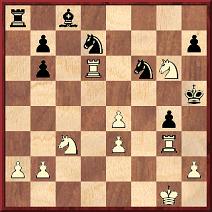
28...Kxg6
Capablanca: ‘If 27...hxg6 28 e5.’
Lasker: ‘A shameful blunder. After 27...hxg6 Black stands very well.’
Alekhine (who awards 27...Kxg6 a double question mark): ‘The final mistake. After 27...hxg6 Black could still have defended himself, although the winning chances would have remained with White.’
Bogoljubow: ‘Black overlooks the reply. Longer resistance could be achieved with 27...hxg6, but it would hardly have been possible to save the game.’
BCM: ‘If 27...hxg6 28 e5!! but he does not escape this by the course chosen.’
Euwe and Prins: ‘There follows an analysis of the situation after 27...hxg6 28 e5.
A. 28...Ne8 29 Re6 Ng7 {I. and W. Linder give only 29...Nc7 30 Re7.} 30 Re7 Kh6 (forced) [Forster (joint analysis with Hug): ‘No. 30...Kh6 is neither forced nor good. A much better line is 30...Nf5! 31 Rh7+ Nh6 (31...Kg5? 32 Ne4 mate), and there is no win for White: a) 32 e6 Nf6 33 Rh8 Nfg8! or 33 e7 Bd7; b) 32 Nd5 Nxe5 33 Nxb6 Rxa2 34 Nxc8 Nf3+ or 33 Nf6+ Kg5 34 Ne4+ with only perpetual check.’] 31 Rxg4 and owing to the forthcoming 32 Rh4+ – as well as the penetration of a rook to the eighth rank (e.g. 31...b5 32 Rh4+ Nh5 33 Re8 Nb6 34 e6 Kg7 35 e4 and wins) – Black has nothing better than 31...Ra5, after which there follows 32 Rh4+ Nh5 33 Rc4 Rc5 34 e6 Ndf6 35 Rxc5 bxc5 36 Na4 Ng7 37 Nxc5 Nd5 (if 37...Nfe8 then 38 a4 b6 39 Nd7) 38 Rd7 Nb6 (otherwise 39 Rc7 is decisive) 39 Rd8. Ultimately (after a2-a4-a5) Black will have to surrender. Thus would Lasker and Alekhine have played.
B. 28...Ng8 29 e6 Ne5 (29...Nc5 receives the same reply; if 29...Ndf6 there follows 30 e7 and 31 Ne4 or 31 Nd5) 30 Rd8 Ne7 31 Re8 N5c6 32 e4, followed by 33 Nd5 wins. [Forster: ‘If 29...Nc5 30 Rd8 Ne7 then 31 Nd5! Nxd5 32 Rxd5+ Kh6 33 e7 Bd7 34 b4.’]
C. 28...Nh7 29 e6 Ne5 (if 29...Nc5 or 29...Ndf8, 30 e7 is decisive, and if 29...Ndf6 then 30 Rd8) 30 Nd5, and the threat of 31 e7 Bd7 32 Nxb6 or 32 Rxd7 decides the issue.’ [Forster: ‘Instead of 30 Nd5, it is simpler to play 30 e7 Bd7 31 Rd5, winning a piece. It is surprising that apart from Euwe and Prins none of the annotators tried to find out the true value of 27...hxg6. Taking into account my improvement 30...Nf5! instead of 30...Kh6 in variation A of Euwe and Prins, I think that Bogoljubow probably missed a draw here.’] {‘Chess Stars’ gives 29 Rd4 (after 28...Ne8) as another path to victory, but Richard Forster considers that Black obtains a good game with the reply 29...Ra5 (rather than 29...Kh6).}
28 Rxg4+
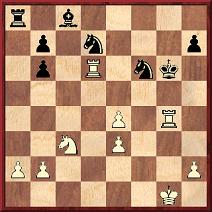
28...Kf7
Euwe and Prins: ‘Or 28 ...Kh5 29 Rg7 Ra5 30 Nd5 Nxd5 31 Rxh7+ Kg5 32 Rg7+ Kh5 33 Rxd5+ Rxd5 34 exd5 and a fourth pawn will soon be lost.’
Golombek: ‘If 28...Kh5 29 Rg3 and the black king is in a mating net.’ In the German edition of Golombek’s book, the translator, Rudolf Teschner, changed this note to: ‘Or 28...Kh5 29 Rg7! with the threat of 30 e5. For example, 29...Kh6 30 Rgxd7, or 29...Ra5 30 Ne2! Rg5+ 31 Ng3+ Kh4 32 Rf7! and wins.’ [Forster: ‘Another very strong possibility is 29 Rf4, and if 29...Ng4 then 30 Rf7!’]
29 Rf4 Kg7
[Forster: ‘29...Ke7 fails to 30 e5 Ne8 31 Nd5+ Kd8 32 Rf8.’]
30 e5 Ne8
Euwe and Prins: ‘Since Black evidently did not wish to resign yet, he would have served his cause best by 30...Ng8. White must proceed with 31 e6. Then would come:
a) 31...Nc5 (31...Nf8), after which 32 Rf7+, followed by 33 Rf8, wins. [Forster: ‘32 Rf7+ is right after 31...Nf8, but after 31...Nc5 White can play 32 Rg4+ Kh8 33 Rd8 Bxe6 34 Rgxg8+ Bxg8 35 Rxa8.’]
b) 31...Ndf6 32 e4 and wins with 33 Nd5.
c) 31...Ne5 32 Nd5, etc.’
31 Re6 Resigns.
Capablanca: ‘After 31...Nc7, 32 Re7+ followed by 33 e6 wins a piece.’
Tartakower: After ‘31...Nc7 32 Re7+ Kg6 (or 32...Kg8 33 e6 Nc5 34 Rxc7 Nxe6 35 Rg4+, and White ends up the exchange and a pawn ahead) 33 e6 Nc5 34 Rxc7 Nxe6 35 Rg4+ Kf5 36 Rcc4, the win for White would be thoroughly secure.’
A number of sources (most importantly Bogoljubow’s tournament book) state that the moves 31...Nc7 32 Re7+ were actually played. In both A Primer of Chess and Kagans Neueste Schachnachrichten, Capablanca indicated that Black resigned after 31 Re6.
Bogoljubow: ‘From start to finish an extremely exciting game, which contains infinitely more subtleties than has generally been suggested. Unfortunately the finish was marred by Black’s time trouble.’
Alekhine: ‘A very amusing game, to be sure, but not at all what the chess world has the right to expect from a meeting between the tournament winner and the world champion.’
In the last three rounds of the tournament Bogoljubow and Lasker scored respectively one point and 1½ points out of three, while Capablanca achieved two points out of two. The final standings were thus: 1. Bogoljubow 15½; 2. Lasker 14; 3. Capablanca 13½. As at Bad Kissingen, 1928, Capablanca finished behind Bogoljubow, but defeated him in their individual game.
Bibliography
Books:
Publications:
This article appeared on pages 76-89 of the 3/1996 New in Chess and was reproduced on pages 82-104 of Kings, Commoners and Knaves. Subsequently, the Capablanca v Bogoljubow game was annotated, in particular, on pages 302-307 of part one of Garry Kasparov on My Great Predecessors (London, 2003).
Addition on 30 December 2007: In C.N. 5361 Charles Sullivan (Davis, CA, USA) commented that such annotators as Bogoljubow, Reinfeld and Kasparov had indicated that 17 Qf7 was inferior to the move played by Capablanca (17 Qxb6), owing to 17...Rf8. However, Mr Sullivan suggested that 17 Qf7 might be objectively preferable, because after 17...Rf8 the previously-neglected move 18 Qe7 apparently leads to a position which Black cannot win. On 4 August 2008 the same correspondent pointed out to us that the line 17 Qf7 Rf8 18 Qe7 had previously been given by Sergey Sorokhtin, in a database file accessible via a link towards the end of a ChessBase article.
Our article provides an English translation of Capablanca’s annotations published on pages 34-35 of Kagans Neueste Schachnachrichten, January 1926. We have now obtained a copy of the Cuban’s original manuscript:
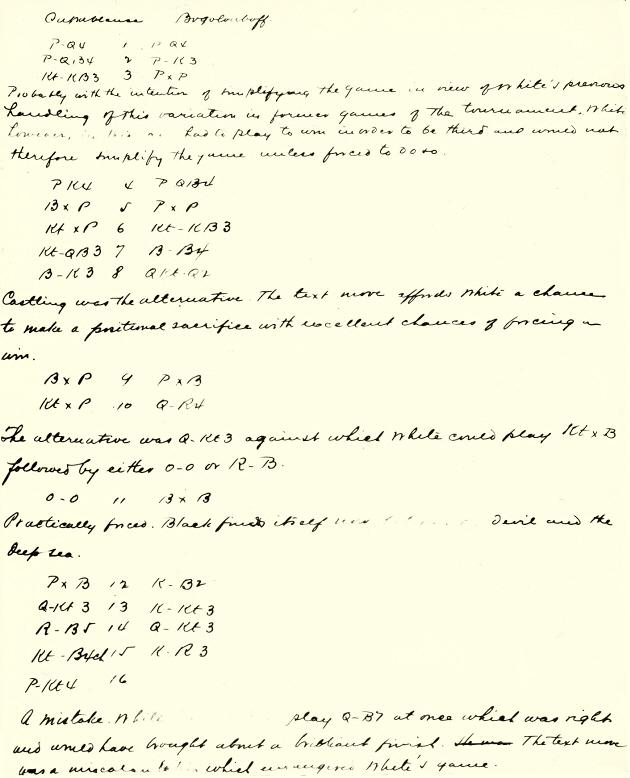
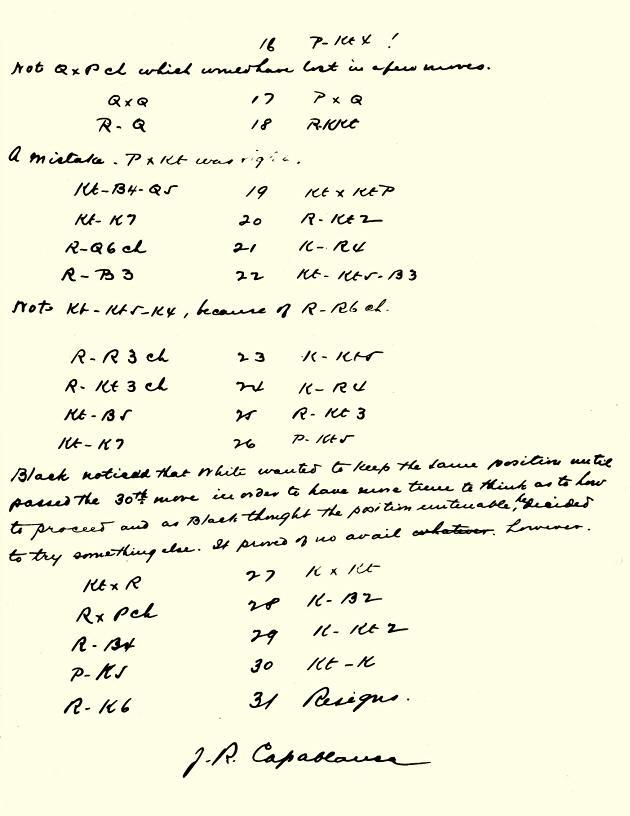
(8613)
C.N. 5057 showed the following listing in a Capablanca section on page 65 of the Gazette of the Grolier Club, June/December 1975:

See too Moscow, 1925 and Capablanca on Moscow, 1925.
To the Chess Notes main page.
To the Archives for other feature articles.
Copyright: Edward Winter. All rights reserved.